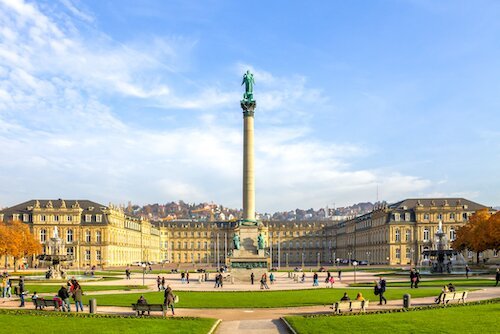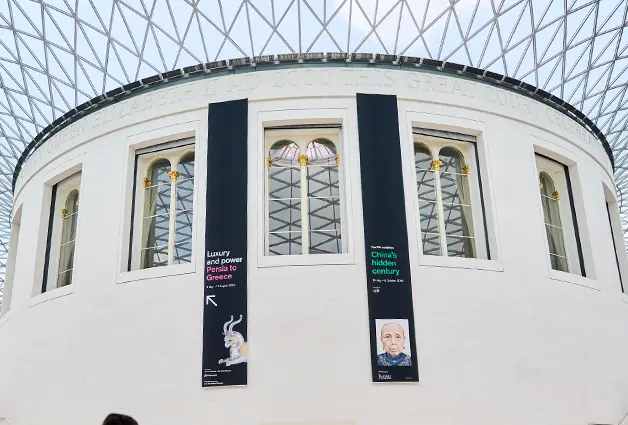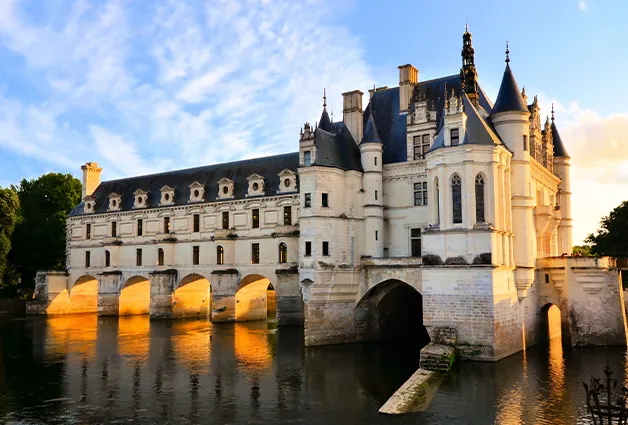Some of the best things to do in Stuttgart
Hauptbahnhof

Many journeys begin or end at the Hauptbahnhof. It is Stuttgart’s primary train station, and travelers can take a trip to most major destinations in Germany from the Hauptbahnhof.
Opened in 1922 and designed by architect Paul Bonatz, the Hauptbahnhof withstood the bombs of World War II and is one of the most prominent historical landmarks in the city. In recent years, plans to demolish some parts of the station to modernize it have been met with fierce local opposition.
Perhaps, the most iconic part of the Hauptbahnhof is the rotating illuminated Mercedes-Benz sign that sits atop a 12-story tower located at the station.
Stadtbibliothek Stuttgart

The city library, Stadtbibliothek, is 11 minutes away from Hauptbahnhof. It's rather unusual to recommend a library as a place to visit while you're on vacation. However, there's a good reason for this.
Designed by South Korean architect Eun Young Yi with inspiration from the ancient Pantheon, the building housing the library is fascinating in many ways. Its contemporary exterior has a simple but elegant look that makes you want to stare. The pristine white interior illuminated by the central roof light gives it a pure and serene ambiance.
Once you're done ogling the orderly shelf arrangements, stop by Café Lesbar at the top for refreshments. Feel free to ignore the books. You're here to take in the beauty of the building. However, if you feel guilty about not reading a book in the library, pick one up and enjoy it in one of the reading rooms.
If you think a library building couldn’t possibly look any better, stop by at night to enjoy the view as the panels light up to reveal an even more beautiful side of the building's modern architecture.
Schlossplatz

Schlossplatz is Stuttgart’s famous palace square. It is a popular destination for locals and tourists throughout the year thanks to its vast expanse of well-manicured lawns, and the city’s famous Christmas markets that open in November.
The Schlossplatz is the beating heart of the city. It is centrally located near Stuttgart’s other popular tourist attractions so tourists can conveniently explore landmarks on foot.
Visitors can experience regular events at the Schlossplatz including festivals and concerts. The square is right next to the Wurttemberg State Museum, which is housed in the former Old Palace of the Wurttemberg region. The museum was founded in 1862 and is filled with an assortment of carefully categorized treasures and masterpieces from German history.
Fernsehturm

The Fernsehturm tower stands 710-feet tall and looks over Stuttgart like a proud protector. Fernsehturm was the world’s first television tower as it beamed signals to antennas all over the southwest region of Germany.
The tower began operating in 1956 and quickly became the prototype for similar towers in other cities around the world. Today, the Fernsehturm is arguably Stuttgart's No. 1 landmark.
Tourists can ascend the tower to dine at the Panorama Cafe or the Restaurant Leonhardts. There is also an observation deck at the top of the tower that provides beautiful views of Germany’s sixth largest city.
Ludwigsburg Palace

About 40 minutes away from the city center, Ludwigsburg Palace is a sprawling 18th-century Baroque palace with grounds that rival the best of French chateaus. Commissioned by then Duke of Württemberg, Eberhard Louis as a ducal residence, construction commenced in 1704 but wasn't completed until 1733.
It is one of the largest Baroque palaces in Europe and is nicknamed the Versailles of Swabia. The palace has four wings and includes 18 buildings with a mind-blowing 452 rooms.
Walking through the rooms of the palace takes visitors through Baroque, Rococo, and Neocalssical features, thanks to the different renovations that occurred after the death of Eberhard Louis.
The palace now houses several museums, including a fashion museum that stages shows with clothing from the 18th to the 20th centuries. Other museums include the Ceramic Museum showcasing contemporary ceramic art, the Kinderreich Children’s Museum, and the Baroque Gallery.
The grounds around the palace have lawns and gardens with intricate geometric patterns that rival those seen in Château de Chantilly in France and can be best appreciated via aerial views.
Cannstatter Volksfest
The Cannstatter Volksfest is one of the world’s largest festivals. The festival has been running for over 200 years, and it is a staple of the Stuttgart area. It takes place in late September and runs until the middle of October attracting visitors from all over the world.
So, what is the annual Cannstatter Volksfest? It is a beer festival and traveling funfair. Most tourists know the event as the Stuttgart Beer Festival. One of the most significant events of the entire festival is the annual tapping of the keg which takes place during the opening ceremonies.
Visitors to the Cannstatter Volksfest will find plenty of rides, food and drink, and a large parade during its opening weekend. The festival is a family affair and has been for over two centuries.
Porsche Museum

The Porsche Museum showcases the company’s history through a beautiful exhibit of 80 classic Porsche vehicles. Visitors can learn about Porsche from the days of its founder Ferdinand Porsche up until today.
The Porsche Touch Wall is arguably the most popular exhibit in the museum. Automobile enthusiasts can browse through images, advertisements, and automobile concept drawings at the touch of a finger. There is also an area in which visitors can produce a variety of Porsche car sounds and mix them into a song.
Mercedes-Benz Museum

The Mercedes-Benz Museum offers visitors 160+ cars to explore. Some go back to the company's origins. Not only can visitors view the company’s cars, but they will also find the world's first-ever motorcycle which was built in 1885 by Daimler.
Along with a large number of cars, visitors can learn about Mercedes' long history. The museum contains 1,500 exhibits over nine floors. Car enthusiasts will find a whole lot more than automobiles inside the Mercedes-Benz Museum.
Killesbergturm Tower

Situated in the beautiful Killesberg Park in Stuttgart, the Killesbergturm Tower was built for the World Horticultural Exposition in 1993, but some delays in the process caused the project's completion to stall until 2001. Today, it's a popular attraction in the city and you can walk up the 42-meter-high steel mesh tower for some incredible panoramic views of Stuttgart. Before that, take a walk in the park to burn off some holiday calories.
If you're not a fan of heights, you can still enjoy the architectural beauty of the award-winning tower from a safe distance.
Standseilbahn

Standseilbahn is a 536m funicular railway opened in 1929. It is well preserved, and the teak cable cars have maintained their look over the years. The funicular takes passengers up the 28% incline from Südheimer Platz Valley station to the Waldfriedhof in the southern part of Heslach.
Funicular railways are uncommon in cities, so visitors shouldn't miss the opportunity to ride on the Standseilbahn. If you have an urge for an uphill hike, you'll find other appropriate locations.
Stuttgart city is a beautiful German city that shines brightly. Its connection to the automotive world makes it a must-visit destination for car lovers. But the city has a lot more to offer than just cars. It is also a city of intriguing history, technology, and gorgeous landmarks waiting to be explored.
Weather

Local Favorite: Maultaschen
Stuttgart is found in Germany's Swabia region, and the southwestern area has its own distinct history, culture, and cuisine. Maultaschen is arguably the most identifiable food in the region and is a popular dish in Stuttgart. Maultaschen are oversized pieces of ravioli typically filled with onions, meat, and spinach. They are served in either a salad that is steamed, pan-fried, or dunked in beef-broth-like dumplings. Modern chefs around Stuttgart have created new ways to serve up maultaschen, with some restaurants serving maultaschen burgers, for example. According to legend, monks at the Maulbronn Monastery invented maultaschen to get around the ban of eating meat during Lent.











